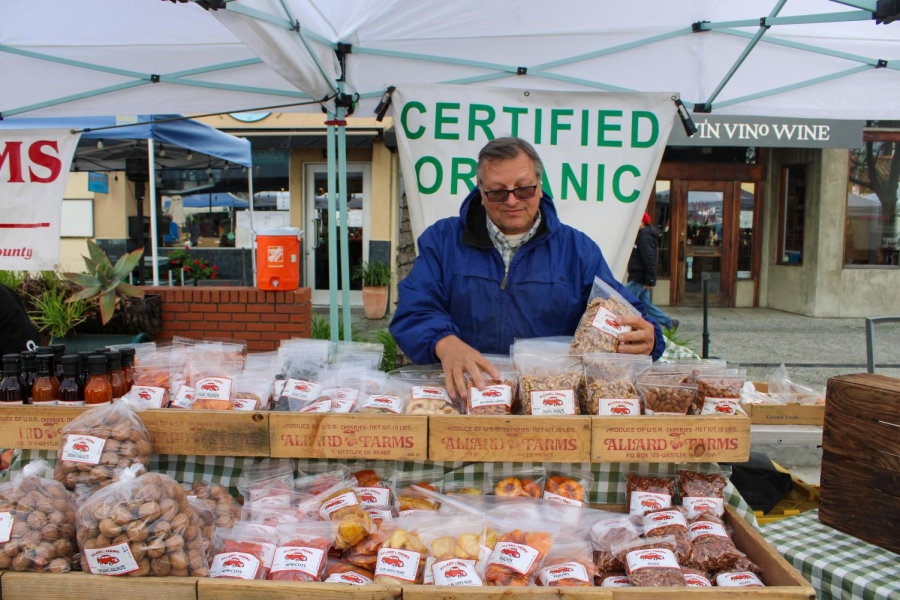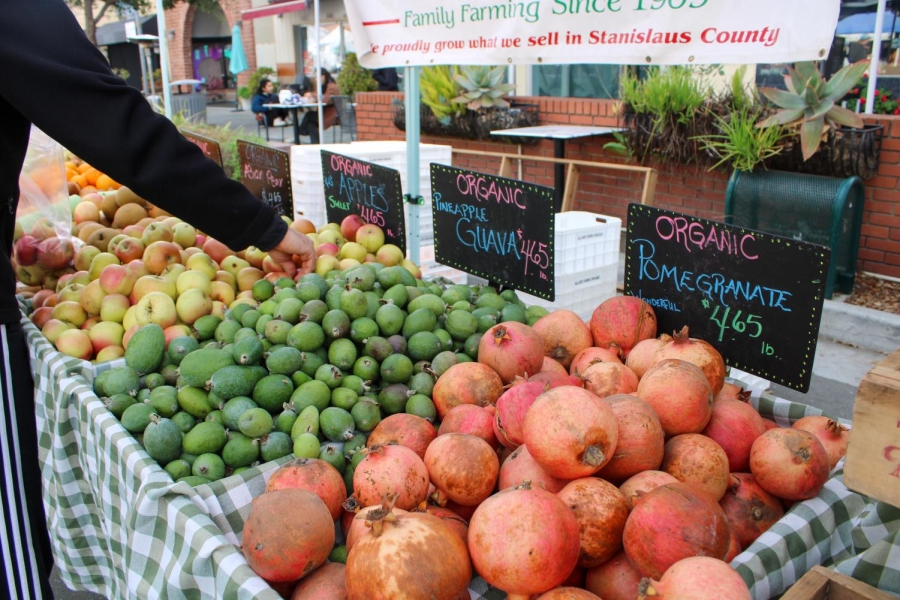Meet me at the market: Vendors on California Ave. connect local community
STOCKING SHELVES — Jack Manetti arranges Allard Farms’ supply of walnuts. “We’ve been in the business for over 100 years,” Manetti said. Photo: Ajin Jeong
Every Sunday morning, the stretch of California Ave. between El Camino Real and Birch Street comes alive with locally grown produce, freshly prepared food and live music. The farmers’ market is a point of contact for Palo Altans to meet local farmers and taste a wide variety of fresh fruit and vegetables from all over Northern California.
Christopher Gardner, author and Stanford nutrition studies professor, said that it is important to attend the farmers’ market because it allows consumers to form relationships with farmers.
“Both as a consumer and a scientist in the department of medicine that’s very concerned about how disconnected we have become from food, going to the farmers’ market is just amazingly refreshing to me,” Gardner said. “These are the people who grow food on their land, and they bring it here.”
Gardner also noted the unique benefit of knowing where and how the food at the market was treated and grown.
“We go to the grocery store and go down one aisle after another, you never see who produces your food, and you grab whatever looks tasty,” Gardner said. “When you’re at the farmers market, you get to see the food and you get to ask ‘Where’s your farm? How are things going? Are you trying to be organic or not?’”
The vendors come from all walks of life bearing a wide variety of products. Verde had the opportunity to speak with a few; here is what we found.
Bread Apeel & Gourmet Crepes
One of the most familiar and beloved stands at the market is the ever-busy banh mi and crepe stand. The Nguyen family has been cooking up the delicious creations for 13 years.
According to stand worker Henry Nguyen, the farmers’ market business is lucrative and the community is welcoming.
“It’s the environment, and the people right here are really nice,” Nguyen said.
Nguyen also noted that part of the reason his family loves the market is the generations of community members that continue to return.
“The kids grow up, they eat, they travel, they always come back,” Nguyen said. “They go to school out of state, but they always come back and they still come here to support us.”
Palo Alto High School senior Brooke Threlkeld likes to visit the stand to buy crepes whenever she can.
“I come fairly often, a couple times a month,” Threlkeld said. “Because I live pretty close by, it’s pretty easy to come and get it in the mornings on Sundays, and the crepes taste really good.”
Allard Farms
For Allard Farms in Westley, California, it’s all about family and tradition. And fruit. The family-owned business sells a variety of brightly colored organic fruits and vegetables. Allard Farms has been operating at the Cal Ave. market since it opened, but they have been in business since 1909. At their stall in the Cal Ave. farmers’ market, Jack Manetti is in charge.
According to Manetti, the Palo Alto community is a lucrative market for their organic produce.
“It’s the community here, the pricing,” Manetti said. “It’s a high value customer, so they’re willing to pay the prices for organic fruit.”
From the time that Manetti has spent at the market, the main takeaway that he has observed is the way generations of people return to the market, sometimes years later with their own children, similar to Nguyen’s statement.
Houweling Nurseries Oxnard
Beverly Tamai, a Houweling employee, dons a tomato-shaped hat made of red felt as she carefully cuts tomatoes off their stems.
Their tomatoes are grown in greenhouses hydroponically — using nutrient-rich solutions instead of soil. Because of this, Tamai’s tomatoes weren’t flooded by the rainfall, but were affected in other ways.
“We need sunlight and we need a consistent temperature,” Tamai said. “Trying to control that atmosphere and keep it constant is pretty difficult when you have outdoor elements like that [flooding] that are fluctuating.”
Tamai said the stand has found success in Palo Alto.
“We do well here in Palo Alto because I think the community is very health-conscious and they’re trying to eat healthy as well as considering local farms and keeping it sustainable,” Tamai said. “And they prefer organic or even hydroponic, which to me is like the next step up from organic because we eliminate the need to spray and use pesticides.”
Tamai has been selling for Houweling Farms Oxnard for 25 years, but before that, she worked in farmers’ markets selling products from her family’s farm.
Her commitment is affirmed by her commute: Houweling is in Camarillo, 350 miles south of Palo Alto.
“I now reside here, but three weeks ago when we started our season, I drove down and back, waiting to load up. … It’s a 14 or 15-hour day,” Tamai said. “I represent two other farms. If I don’t do this, you won’t see them [the farms]. I have 45 years of going.”
Heirloom Organic Gardens
Dozens of plastic bins overflow with dark leafy greens at the stall of Heirloom Organic Gardens from Hollister, California. Cashier Steven Devine noted issues with the farm that have resulted from the recent extreme rainfall.
“We had a broken levee, and that affected it, but overall it was kind of a good thing for the greens,” Devine said.
Palo Alto resident Mark Ostrau said he is a fan of Heirloom Organic Gardens, and of farmers’ markets in general.
“Both the quality is better, but more importantly, I’m a big proponent of being able to purchase directly from the farmers,” Ostrau said.
Ostrau also noted some changes that he has observed.
“Some vendors come in and some come out,” Ostrau said. “And there’s been a little more of a growth in the prepared foods side. But otherwise, one nice thing is that it doesn’t change a ton, so you sort of know who the vendors are, and you get a sense of who they are and what they do.”




